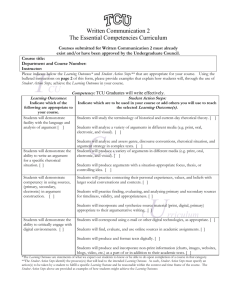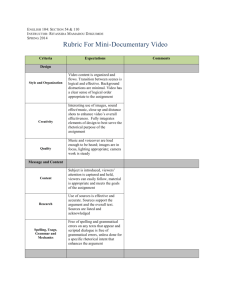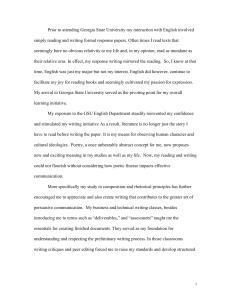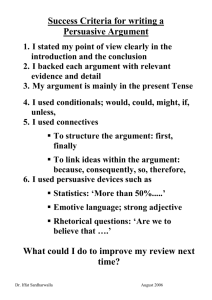English 102 Essay 2: Reading Visual Arguments
advertisement
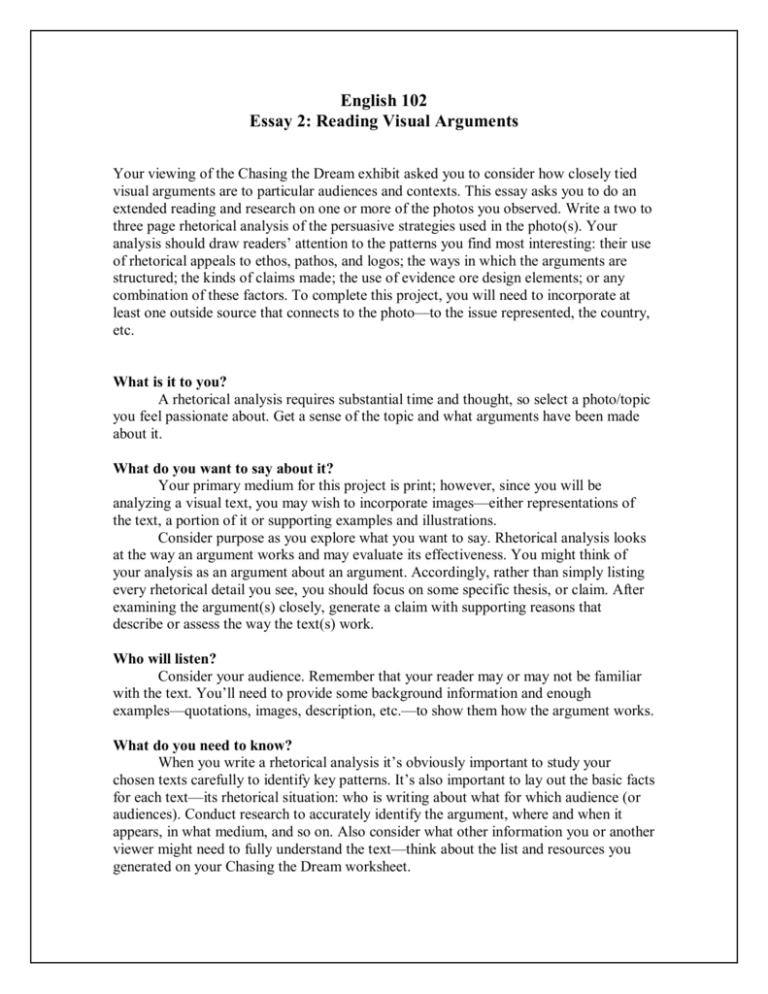
English 102 Essay 2: Reading Visual Arguments Your viewing of the Chasing the Dream exhibit asked you to consider how closely tied visual arguments are to particular audiences and contexts. This essay asks you to do an extended reading and research on one or more of the photos you observed. Write a two to three page rhetorical analysis of the persuasive strategies used in the photo(s). Your analysis should draw readers’ attention to the patterns you find most interesting: their use of rhetorical appeals to ethos, pathos, and logos; the ways in which the arguments are structured; the kinds of claims made; the use of evidence ore design elements; or any combination of these factors. To complete this project, you will need to incorporate at least one outside source that connects to the photo—to the issue represented, the country, etc. What is it to you? A rhetorical analysis requires substantial time and thought, so select a photo/topic you feel passionate about. Get a sense of the topic and what arguments have been made about it. What do you want to say about it? Your primary medium for this project is print; however, since you will be analyzing a visual text, you may wish to incorporate images—either representations of the text, a portion of it or supporting examples and illustrations. Consider purpose as you explore what you want to say. Rhetorical analysis looks at the way an argument works and may evaluate its effectiveness. You might think of your analysis as an argument about an argument. Accordingly, rather than simply listing every rhetorical detail you see, you should focus on some specific thesis, or claim. After examining the argument(s) closely, generate a claim with supporting reasons that describe or assess the way the text(s) work. Who will listen? Consider your audience. Remember that your reader may or may not be familiar with the text. You’ll need to provide some background information and enough examples—quotations, images, description, etc.—to show them how the argument works. What do you need to know? When you write a rhetorical analysis it’s obviously important to study your chosen texts carefully to identify key patterns. It’s also important to lay out the basic facts for each text—its rhetorical situation: who is writing about what for which audience (or audiences). Conduct research to accurately identify the argument, where and when it appears, in what medium, and so on. Also consider what other information you or another viewer might need to fully understand the text—think about the list and resources you generated on your Chasing the Dream worksheet. How will you do it? Examine the logical appeals: Look carefully at how well the claims made in a piece are stated, qualified, and supported. Be specific in identifying these appeals, quoting from verbal/written arguments and describing visual arguments. Examine emotional appeals: Is the argument enhanced by legitimate emotional appeals? Identify these emotions, explain how they are generated, and evaluate their relevance to the claim offered. Again, be specific. Examine ethos: Assess the credibility of the writer, artist, or sponsoring institution. Is the argument presented by someone you are moved to trust? Is the appeal honest? Do you find yourself identifying with the argument? Explain precisely why, using specific evidence from the argument you are analyzing. Also consider how each text treats rebuttals or alternative perspectives. Does the argument show an awareness of alternative perspectives or points of view? How well does the argument answer obvious objections? How well does it work? Once you’ve completed a draft, review your analysis to see that your argument is clearly organized, engaging, and persuasive. Be sure you accurately cite and document all outside sources. For our purpose, use in­text citations—giving the author and page number in parenthesis (Smith 17). Essay Two Due in­class Wednesday, February 21 st
